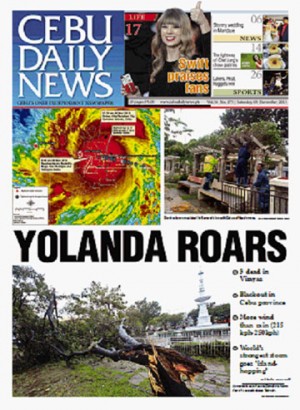
However, supertyphoon Yolanda, which carried more punch than 1990’s Ruping, brought less rain and devastation across Cebu island when it struck before 10 a.m. yesterday.
By noontime, the worst of the fury was over. In the evening, the storm was heading out of the country.
Two deaths were confirmed in Cebu. A woman in Medellin town was killed by a coconut tree that fell on her and a tugboat captain in west coast Balamban town fell of his boat in the pier.
Weathermen said Yolanda, which packed gusts of 250 kilometer per hour in the Philippines, was the strongest in the world this year.
A blackout engulfed the province at 2:13 p.m. when the Cebu-Negros-Panay grid shut down but portions of Cebu City had electricity restored starting 7 p.m.
Rainfall was light to intermediate all morning, when Yolanda made its third landfall in Daanbantayan town at 9:40 a.m.
The seaside towns in the northern tip of Cebu island took the brunt of the storm.
A CDN team staying in Daanbantayan municipal hall saw tin roof sheets flying in the air while strong winds dragged parked cars and motorcycles.
Gov. Hilario Davide III said there was “extensive damage” in Bantayan Island and mainland towns of Bogo, Medellin and Tabogon, mainly to houses and public buildings, though detailed reports have yet to come in.
Because of the storm damage, he said the state of calamity declared in Cebu province after the Oct. 15 earthquake would still be in effect.
Calling Cebuanos “resilient”, he urged people to “have strong faith and help each other.”
A blackout affected Cebu province but after 5 p.m., the Visayan Electric Company was slowly restoring power in several Cebu city barangays, including parts of Cebu Business Park following its own preventive shutdown at 9:30 a.m. (See story on page 4)
Oscar Tabada, OIC of Pagasa Visayas, said Yolanda’s strongest winds in Cebu City were felt at 9:28 a.m. with a speed of 126 kph – a big difference from 215 kph winds that slammed Cebu in typhoon Ruping 13 years ago.
By today, Cebu will have ”slight rain but the sun will finally come out,” he told Cebu City Mayor Michael Rama.
The mayor, who credited the protection of the Sto. Niño for the minimal damage, offered a thanksgiving Mass at the the Cebu Metropolitan Cathedral at 5 p.m.
Tabada said Cebu City was “lucky” because it was far from the eye of the storm in Daanbantayan town where wind velocity reached 235 kph. Otherwise, with the city’s dense population, the casualties and damage would have been bigger.
No major infrastructure damage was reported in Cebu, Mandaue and Lapu-Lapu Cities.
The wind was strong enough to uproot a century-old acacia tree near the Magellan’s Cross as well as one next to the Mabolo church in Cebu City.
Another large tree in Fuente Osmena park collapsed on the fence, aside from the scaffolding of the half-completed giant Lhuillier Christmas tree in the park.
The storm struck in the morning, unlike typhoon Ruping’s dawn assault, and this time local governments and residents had three days warning.
Vice Mayor Edgar Labella said the damage from ‘Yolanda’ could have been worse if not for the preparations of the city government and the Cebuanos in general.
“The city has long prepared for the typhoon and the people were equally aware of what they are supposed to do,” he said.
Paired with the “power of prayers”, Labella said preparations of the city and its residents minimized the impact of the typhoon as compared to the time of typhoon Ruping which caught the people off guard at dawn.
In contrast, typhoon Ruping left Cebu without power and running water for almost three weeks in November 1990. Over 80 vessels sank in the Cebu harbor and one foreign vessel, the MV Sanko Elegance broke loose from its moorings and slammed a pillar of the Mandaue-Mactan Bridge, forcing its closure for months.
A command center was set at the mayor’s office since Wednesday, coastal residents were evacuated Wednesday night to sports centers and public schools,
Of three trees uprooted in Plaza Sugbo in front of City Hall, one was a narra tree about 15 years old, and a eucalyptus tree 20 to 30 years old, said Alrie Gesta of the Parks and Playgrounds commission.
No deaths were reported.
About 18,300 people were sheltered in evacuation centers in barangay halls, spots complexes , schools and chapels.
None of the facilities of the Metro Cebu Water district were damaged, said general manager Armando Paredes.
However, due to the power blackout, only the Tisa facility was running, supplying 4,000 cubic meters a day to Central Cebu City so MCWD deployed generator sets to wellfields in Jaclupan and Mactan, and to Guadalupe, Banawa and Tisa.
Police said there were 118,997 evacuees in Central Visayas as of 1 p.m.
A total of 36,780 families were staying in 766 evacuation sites in the region.
There were 16 impassable roads: Mandaue (2), Lapu-Lapu (2), Cebu City (2), Bohol (9) and Negros Oriental (1)/with correspondents Michelle Joy L. Padayhag and Peter Romanillos